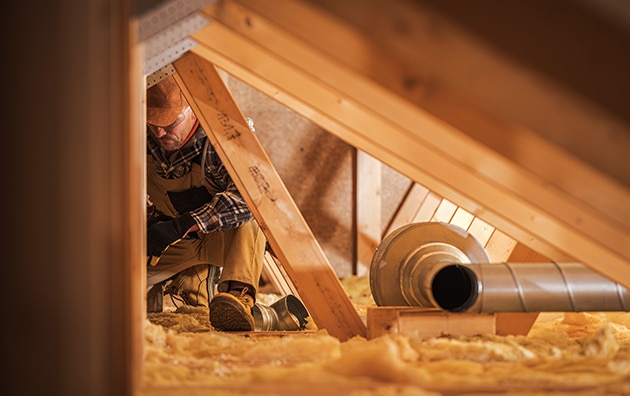Tips for Managing Rain in Your Attic in Your Home
Information for Homeowners


In recent years, there has been a growing emphasis placed on energy-efficiency in construction and in building codes throughout Canada. In residential construction, a great deal of energy can be saved by increasing how well a home is insulated minimizing heat transfer with the outside environment. During the colder months of the year, this translates into a colder attic space than what was historically found in homes as less radiant heat loss is occurring into the attic area. However, if there is any significant leakage of warm moisture-laden air from inside the conditioned space into the attic, there is a high likelihood that it will condense as frost on any cold surface during the winter months. This can become troublesome when there is a sudden increase in ambient air temperature or solar radiation as this causes these previously cold surfaces to heat up and begin to turn the frost into liquid water, which “rains” down onto the insulation. While small amounts of frost inside the attic space is normal and typically won’t cause any issues, this phenomenon of “attic rain” has the potential to lead to numerous complications and may in fact be a symptom of another more serious problem.
In residential construction, 6mil (0.15mm) polyethylene sheeting (poly) is typically used as both the air and vapour barrier between the conditioned space and unconditioned attic. As this bulletin is in reference to attic rain, the term “air barrier” will be used to describe this transition point between the two spaces.
Causes
Attic rain is caused by the rapid melting of excessive ice/frost in the attic of a residential building. In the winter months, this frost begins to accumulate when excess moisture enters an unconditioned attic. Typically, excess moisture occurs in this area due to the following:
- Holes and discontinuities in the air barrier between conditioned and unconditioned spaces.
- A positive pressure differential between the conditioned and unconditioned space.
New residential construction requires a much tighter building envelope and utilizes sealed combustion furnaces which require fresh air intakes in order to ventilate the home. This creates a small amount of positive pressure each time the furnace operates. This positive pressure can force moisture-laden air from the conditioned interior space into the cold attic area through any opening in the building envelope. The more breaches or holes into the unconditioned attic space, the more moisture is available to condense as frost during the colder portions of the year.
There are two types of attic rain: localized and generalized. Localized attic rain is created by larger holes or penetrations into the attic space, or by improperly sealed exhaust vents, attic access hatches and poly hats at fixture locations. Generalized attic rain typically occurs throughout the entire attic area and may be exacerbated by high humidity levels from inside the home.
The phenomenon of “attic rain” was not commonly seen in older homes typically being constructed with B vent furnaces which cause a negative pressure in the home while operating, therefore drawing the cooler drier air into the home allowing drying of the attic to occur.
Prevention
While frost accumulation in the attic typically cannot totally be prevented from occurring, the severity of it can be controlled. The easiest and most economical way is to limit the holes and discontinuities in the air barrier between the conditioned space and the attic area at the time of construction. This can be accomplished by ensuring the following:
- Adequate backing is in place at all joints in the air barrier and at the poly hats/exhaust fan housings which will allow for a compression seal when drywall is installed.
- Joints in the air barrier and junctions between the air barrier and the poly hats/exhaust fan housings are sealed with acoustical sealant. Construction tapes are not adequate and will fail.
- All electrical penetrations through the top plates and poly hats are sealed with an appropriate sealant such as spray foam. Acoustical sealant is not recommended for these applications as the product is non-curing and may not maintain an airtight seal over time.
- Duct to roof boot connections are properly sealed within the attic.
- The attic access hatch is properly constructed, insulated and sealed.
- Pre-manufactured attic access hatches are preferred as they feature cam-locks which provide uniform compression of the gasket and greatly reduce air leakage.
Instructing the homeowner to operate the ventilation fan throughout the colder months will help reduce the chances of attic rain occurring as it equalizes the pressure between the exterior and interior of the home. Unfortunately, this is not a very cost-effective solution. A simpler and more economical alternative is the installation of a Heat Recovery Ventilation/Energy Recovery Ventilation (HRV/ERV) system. These devices equalize pressures and improve the indoor air quality.
It is important to note that attic rain is not a result of a lack of roof vents. Additional venting will not help prevent the issue of attic rain; the venting prescribed in the building codes has proven to be adequate and adding additional venting may only make the problem worse.